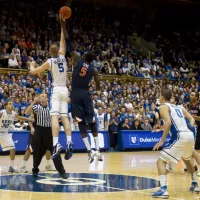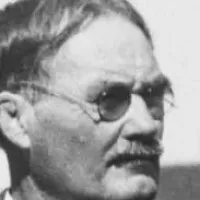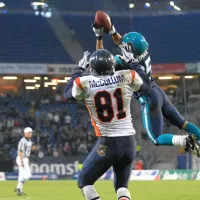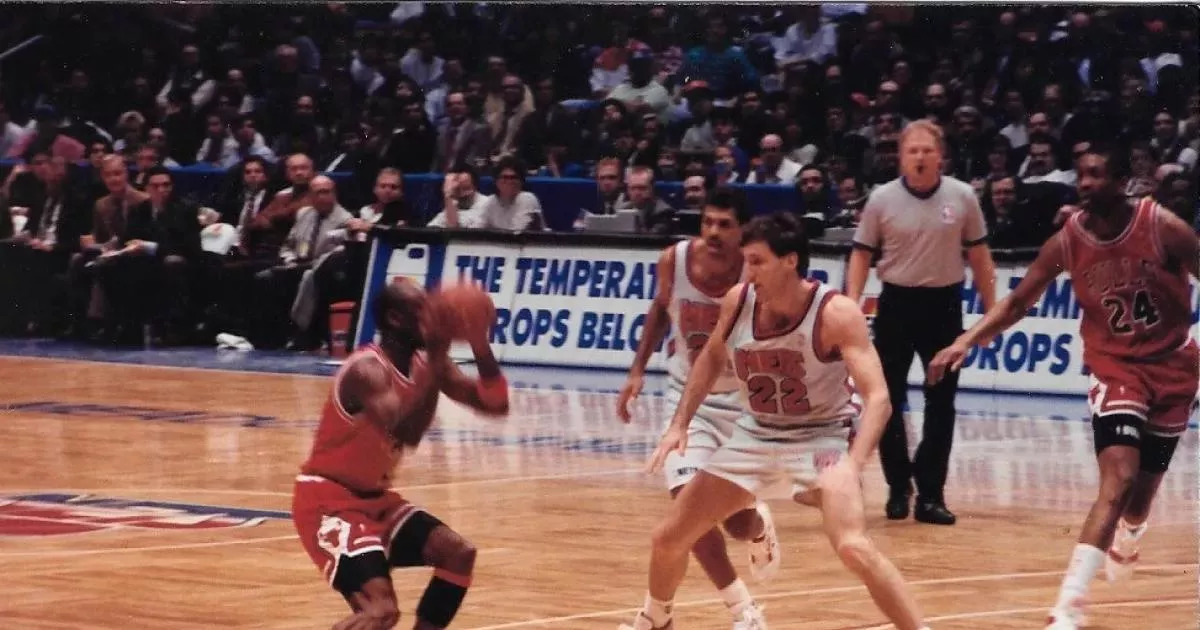Basketball is a team sport played on a rectangular court between two teams, typically of five players. The objective is to score by shooting a ball through the opponent's hoop (basket) while preventing them from doing the same. Points are awarded based on the shot's location: two points for shots inside the three-point line and three points for shots from beyond it. Free throws, worth one point each, are awarded after fouls. The team with the most points at the end of regulation time wins. If the score is tied, an overtime period is played to determine the winner.
1901: Colleges begin sponsoring men's basketball
In 1901, several colleges, including the University of Chicago, Columbia University, Cornell University, Dartmouth College, the University of Minnesota, the U.S. Naval Academy, the University of Colorado and Yale University, started sponsoring men's basketball games.
1902: Berenson editor of Spalding's Women's Basketball Guide
In 1902, Senda Berenson became the editor of A. G. Spalding's first Women's Basketball Guide.
February 6, 1904: First Canadian interuniversity basketball game
On February 6, 1904, the first Canadian interuniversity basketball game was played at YMCA in Kingston, Ontario, with McGill University defeating Queen's University 9–7 in overtime.
1904: Demonstration Tournament
In 1904, a basketball demonstration tournament was held.
1905: Formation of the IAAUS
In 1905, President Theodore Roosevelt, concerned about frequent injuries in college football, suggested the formation of a governing body, leading to the creation of the Intercollegiate Athletic Association of the United States (IAAUS).
1905: Creation of National Women's Basketball Committee
In 1905, the American Physical Education Association created the executive committee on Basket Ball Rules, also known as the National Women's Basketball Committee. This committee established rules that included six to nine players per team and 11 officials.
1906: Metal hoops replace peach baskets
In 1906, the original peach baskets used as goals in basketball were replaced by metal hoops with backboards, which allowed the ball to pass through more easily and changed the game.
1910: IAAUS renamed to NCAA
In 1910, the Intercollegiate Athletic Association of the United States (IAAUS) changed its name to the National Collegiate Athletic Association (NCAA).
1915: Edmonton Grads begin operations
In 1915, the Edmonton Grads, a touring Canadian women's team based in Edmonton, Alberta, began operations.
1917: National Interscholastic Basketball Tournament begins
In 1917, the National Interscholastic Basketball Tournament began at the University of Chicago, organized by Amos Alonzo Stagg and inviting state champion teams.
1924: International Women's Sports Federation Basketball Competition and Olympics tournament win
In 1924, the International Women's Sports Federation included a women's basketball competition. Also, the Edmonton Grads won one of four consecutive exhibition Olympics tournaments this year.
1924: National Catholic Interscholastic Basketball Tournament begins
In 1924, the National Catholic Interscholastic Basketball Tournament began and ran until 1941 at Loyola University.
1925: Women's High School Basketball Tournaments
By 1925, 37 women's high school varsity basketball or state tournaments were held.
1926: AAU Backs National Women's Basketball Championship
In 1926, the Amateur Athletic Union (AAU) backed the first national women's basketball championship, using men's rules.
1928: Olympics tournament win
In 1928, the Edmonton Grads won one of four consecutive exhibition Olympics tournaments.
1929: National Interscholastic Basketball Tournament grows
In 1929, the National Interscholastic Basketball Tournament at the University of Chicago had grown to include 29 state champion teams.
1929: National Interscholastic Basketball Tournament for Black High Schools held
In 1929, the National Interscholastic Basketball Tournament for Black High Schools was held at Hampton Institute, running until 1942.
1929: First women's AAU All-America team chosen
In 1929, the first women's AAU All-America team was chosen.
1930: Last National Interscholastic Basketball Tournament
In 1930, the last National Interscholastic Basketball Tournament was held due to opposition from the National Federation of State High School Associations and North Central Association of Colleges and Schools, who feared it was being used to recruit professional players.
1932: Olympics tournament win
In 1932, the Edmonton Grads won one of four consecutive exhibition Olympics tournaments.
1936: Men's basketball debut at the Olympics
In 1936, men's basketball was first included as an official sport at the Berlin Summer Olympics, where the United States defeated Canada in the final.
1936: Olympics tournament win
In 1936, the Edmonton Grads won one of four consecutive exhibition Olympics tournaments.
1937: First men's national championship tournament
In 1937, the first men's national championship tournament, the National Association of Intercollegiate Basketball tournament, was organized; it still exists today as the National Association of Intercollegiate Athletics (NAIA) tournament.
1938: First NCAA National Tournament
In 1938, the first national championship for NCAA teams, the National Invitation Tournament (NIT) in New York, was organized.
1938: Women's national championship rule change
In 1938, the women's national championship changed from a three-court game to a two-court game with six players per team.
1940: Edmonton Grads operations conclude
In 1940, the Edmonton Grads, a touring Canadian women's team based in Edmonton, Alberta, concluded operations.
1941: National Invitational Interscholastic Basketball Tournament held
In 1941, the National Invitational Interscholastic Basketball Tournament was held at Tuskegee Institute, continuing until 1967 with a pause during World War II.
1942: National Interscholastic Basketball Tournament for Black High Schools ends
In 1942, the National Interscholastic Basketball Tournament for Black High Schools ended at Hampton Institute.
November 1, 1946: First BAA Game
On November 1, 1946, the Basketball Association of America (BAA) was formed and the first game was played in Toronto, Ontario, Canada between the Toronto Huskies and New York Knickerbockers.
1948: Gambling scandals rock college basketball
Starting in 1948, college basketball was shaken by gambling scandals, with dozens of players from top teams implicated in game-fixing and point shaving.
1949: BAA and NBL merge to form NBA
In 1949, the Basketball Association of America (BAA) merged with the National Basketball League (NBL) to form the National Basketball Association (NBA).
1950: First FIBA World Championship for men
In 1950, the first FIBA World Championship for men, now known as the FIBA Basketball World Cup, was held in Argentina.
1951: Gambling scandals continue in college basketball
In 1951, college basketball continued to be affected by gambling scandals, with more players being implicated in game-fixing and point shaving, which contributed to the NIT losing support to the NCAA tournament.
1954: National Catholic Invitational Basketball Tournament held
In 1954, the National Catholic Invitational Basketball Tournament was held at various venues, including Catholic University, Georgetown, and George Mason, running until 1978.
1959: Basketball Hall of Fame founded
In 1959, a basketball hall of fame was founded in Springfield, Massachusetts, the site of the first basketball game.
1964: National Invitational Interscholastic Basketball Tournament held at Alabama State College
In 1964, the National Invitational Interscholastic Basketball Tournament was held at Alabama State College and continued until 1967.
1967: American Basketball Association (ABA) emerges
In 1967, the American Basketball Association (ABA) emerged as an upstart organization, briefly threatening the NBA's dominance.
1967: Last National Invitational Interscholastic Basketball Tournament held
In 1967, the last National Invitational Interscholastic Basketball Tournament was held at Alabama State College.
1972: Controversial Olympic Final
In 1972, a controversial final game in Munich against the Soviet Union occurred, in which the ending of the game was replayed three times until the Soviet Union won.
April 9, 1975: Philippine Basketball Association first game
On April 9, 1975, the Philippine Basketball Association's first game was played at the Araneta Coliseum in Cubao, Quezon City, Philippines.
1976: ABA-NBA merger
In 1976, the American Basketball Association (ABA) and the National Basketball Association (NBA) merged.
1976: Women's basketball becomes official Olympic sport
In 1976, women's basketball became an official Olympic sport.
1976: Women's basketball added to the Olympics
In 1976, women's basketball was added to the Olympics, which were held in Montreal, Quebec, Canada.
1978: National Catholic Invitational Basketball Tournament ends
In 1978, the National Catholic Invitational Basketball Tournament ended after being held at various venues, including Catholic University, Georgetown, and George Mason.
1979: Inaugural season of the NBL
In 1979, the NBL, Australia's pre-eminent men's professional basketball league, commenced, playing a winter season from April to September.
1981: Women's National Basketball League begins
In 1981, the Women's National Basketball League began.
1989: FIBA allows NBA players in Olympics
In 1989, FIBA allowed professional NBA players to participate in the Olympics for the first time.
1992: Dream Team at the Summer Olympics
Prior to the 1992 Summer Olympics, only European and South American teams were allowed to field professionals in the Olympics. The United States dominance continued with the introduction of the original Dream Team.
1996: American Basketball League (ABL) Founded
In 1996, the American Basketball League (ABL) was founded.
1997: WNBA Inaugural Season
In 1997, the NBA-backed Women's National Basketball Association (WNBA) began.
1998: NBL shifts to summer season format
In 1998, the NBL transitioned to a summer season format (October–April) to avoid competition with Australian football codes.
2001: NBA D-League formed
In 2001, the NBA formed a developmental league, the National Basketball Development League, later known as the NBA D-League and then the NBA G League.
2004: US suffers first Olympic loss using professionals
In the 2004 Athens Olympics, the United States suffered its first Olympic loss while using professional players, falling to Puerto Rico and Lithuania in group games, and being eliminated in the semifinals by Argentina.
2006: Discovery of Naismith's diaries
In early 2006, James Naismith's handwritten diaries were discovered by his granddaughter, revealing his initial nervousness about the new game he had invented, which was influenced by the children's game duck on a rock.
June 2007: WNBA and ESPN Sign Contract Extension
In June 2007, the WNBA signed a contract extension with ESPN. The new television deal ran from 2009 to 2016.
2007: 3x3 Tested at Asian Indoor Games
In 2007, 3x3 basketball was first tested at the Asian Indoor Games in Macau.
2008: The Redeem Team won gold at the Olympics
In 2008, the Redeem Team won gold at the Olympics.
March 12, 2009: NBA Commissioner Comments on WNBA Profitability
On March 12, 2009, NBA commissioner David Stern stated that the NBA was less profitable than the WNBA in the bad economy and that the WNBA was budgeted to break even that year.
2009: First Official 3x3 Tournaments
In 2009, the first official 3x3 tournaments were held at the Asian Youth Games in Singapore.
2010: B-Team won gold at the FIBA World Championship
In 2010, the B-Team won gold at the FIBA World Championship in Turkey despite featuring no players from the 2008 squad.
2011: FIBA 3x3 Youth World Championships
In 2011, the first FIBA 3x3 Youth World Championships were held in Rimini, Italy.
2012: US wins gold at the Olympics
In 2012, the United States continued its dominance as they won gold at the Olympics.
2014: US wins gold at the FIBA World Cup
In 2014, the United States continued its dominance as they won gold at the FIBA World Cup.
2016: US wins gold at the Olympics
In 2016, the United States continued its dominance as they won gold at the Olympics.
2016: 3x3 Tipped to Become Olympic Sport
In 2016, the sport 3x3 was highly tipped to become an Olympic sport.
2016: High school basketball participation
In the 2016–17 season, 980,673 boys and girls represented their schools in interscholastic basketball competition, according to the National Federation of State High School Associations.
2016: End of WNBA and ESPN contract extension
The WNBA's contract extension with ESPN that was signed in June 2007 ended in 2016.
2017: BIG3 Basketball League Begins
In the summer of 2017, the BIG3 basketball league, a professional 3x3 half court basketball league that features former NBA players, began.
2019: NBA players heights recorded without shoes
Since the 2019–20 NBA season heights of NBA players are recorded definitively by measuring players with their shoes off.
2023: NBA G League
As of the 2023–24 season, the NBA G League has 31 teams.
Mentioned in this timeline
Puerto Rico is a self-governing Caribbean archipelago and island that...
The Union of Soviet Socialist Republics USSR existed from to...

College basketball in the U S is governed by bodies...

James Naismith was a Canadian-American physical educator physician and sports...
Australia officially the Commonwealth of Australia encompasses the Australian mainland...

Football is a family of team sports primarily involving kicking...
Trending

Willson Contreras is a Venezuelan professional baseball player currently playing first base and catcher for the St Louis Cardinals in...

27 days ago Huntington Beach Flooded After Storm; Southern California Experiences Wettest November on Record

8 months ago Crosby and Ovechkin's rivalry continues: A look at their memorable moments and respect.

7 months ago Vrabel on Diggs' Video; Cardi B Dating Rumors Surface About Bills Star

1 month ago Jalen Ramsey's Steelers Safety Switch: Tomlin Intangibles and Echols' Role Highlighted.
Rhamondre Stevenson is a professional American football running back currently playing for the New England Patriots in the NFL He...
Popular

Candace Owens is an American conservative political commentator and author...

Tucker Carlson is an American conservative political commentator known for...

XXXTentacion born Jahseh Dwayne Ricardo Onfroy was a controversial yet...

Ben Shapiro is a prominent American conservative political commentator media...

William Franklin Graham III commonly known as Franklin Graham is...

Bill Gates an American businessman and philanthropist revolutionized personal computing...
